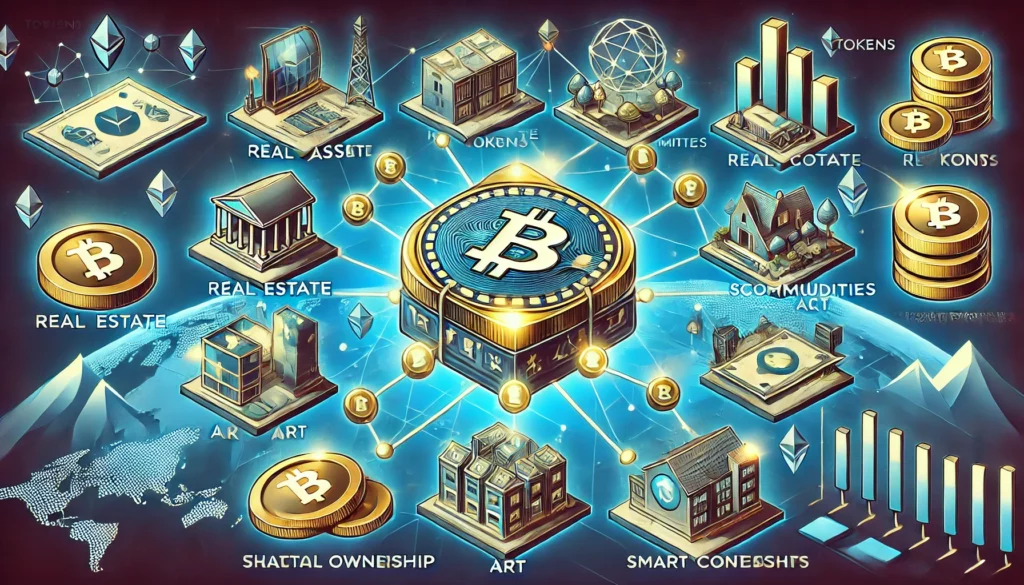The cryptocurrency space has evolved rapidly since the launch of Bitcoin in 2009, with the technology gaining traction in numerous sectors of the economy. Initially, cryptocurrencies were seen primarily as an alternative store of value or medium of exchange, often praised for their decentralized nature and the promise of reducing reliance on traditional financial institutions. However, a new and exciting wave of cryptocurrency innovation is on the rise: the tokenization of real-world assets.
Asset-backed cryptocurrencies are a type of digital asset that represents ownership or a claim on a real-world asset, such as real estate, commodities, art, or even shares of company stock. By using blockchain technology to tokenize physical assets, these cryptocurrencies aim to bridge the gap between traditional markets and the burgeoning digital asset space. The tokenization process brings a host of advantages, including enhanced liquidity, fractional ownership, and accessibility to previously illiquid markets.
In this article, we will explore the emergence of asset-backed cryptocurrencies, the mechanics behind tokenization, their benefits, the challenges they face, and how they could reshape global finance.
What is Tokenization of Real-World Assets?
Tokenization is the process of converting ownership rights of a real-world asset into a digital token on a blockchain. These tokens, often referred to as security tokens or asset-backed tokens, represent a portion or the full value of the underlying asset. Blockchain technology ensures the security and transparency of these tokens by recording each transaction on an immutable ledger, which can be accessed by all participants in the network.
For example, real estate properties, art, or even gold can be tokenized by converting them into digital tokens that represent fractional ownership. Instead of holding a physical deed for a property or a certificate for a commodity, owners can hold a digital token that can be transferred, sold, or used in smart contracts. Tokenization brings traditional, often illiquid assets, into the digital realm, enabling faster, easier, and more efficient transactions.
While traditional finance has long dealt with asset-backed securities, the innovation of tokenization on the blockchain promises a more seamless, global, and efficient way to manage and exchange these assets.
How Does Tokenization Work?
Tokenizing real-world assets involves several steps, combining legal frameworks, blockchain technology, and smart contracts to create a secure and tradable digital asset.
1. Identifying and Valuing the Asset
The first step in tokenization is determining the asset that will be tokenized. This could be a real estate property, a piece of artwork, a commodity (like gold or oil), or even financial assets such as stocks or bonds. The value of the asset is then assessed, either through professional appraisers or market benchmarks, to determine the equivalent value of the token to be issued.
For instance, if a piece of real estate is being tokenized, the value of the property is assessed based on current market conditions. The valuation establishes the number of tokens that will be issued and their individual value, creating a one-to-one relationship between the real-world asset and its token representation.
2. Legal Framework and Compliance
Since tokenized assets represent ownership rights, it’s essential to establish a legal framework that ensures the validity and enforceability of those rights. The tokenized asset must comply with existing regulations, and it must be clear who has the ownership rights and what those rights entail.
Security token offerings (STOs), for example, must comply with securities regulations in the jurisdictions where they are issued. This can involve working with legal experts to ensure that the tokens are structured correctly and comply with rules set out by financial authorities, such as the Securities and Exchange Commission (SEC) in the United States or the Financial Conduct Authority (FCA) in the UK. Token issuers may also need to undergo processes like KYC (Know Your Customer) and AML (Anti-Money Laundering) checks to ensure that the asset tokenization process meets regulatory standards.
3. Issuing the Token
Once the asset has been valued and the legal framework is in place, the next step is to issue the token. This is typically done using blockchain platforms that support the creation of digital assets, such as Ethereum, Polkadot, or Binance Smart Chain. These platforms provide the infrastructure needed to issue tokens, manage ownership, and facilitate transfers.
Smart contracts are often used to automate the issuance and transaction of tokens. These self-executing contracts contain the terms of the agreement and automatically enforce the execution of those terms when predefined conditions are met. For example, a smart contract may govern the sale of a tokenized real estate property and ensure that funds are transferred to the seller once the transaction is finalized.
4. Trading and Transacting Tokens
One of the most significant advantages of tokenization is the ability to facilitate the easy transfer of assets on a global scale. Once a token has been issued, it can be traded on decentralized exchanges (DEXs) or centralized exchanges (CEXs), depending on how the token is structured. This provides liquidity for traditionally illiquid markets, such as real estate or fine art, and allows fractional ownership, where multiple investors can buy and sell portions of the asset represented by the token.
For example, tokenized real estate allows an investor to buy a fraction of a property without the need for a large upfront capital investment. This lowers the barrier to entry for individuals who might not have the resources to purchase an entire property. The process is also much faster compared to traditional real estate transactions, where paperwork and regulatory approvals often take months or even years.
Benefits of Tokenizing Real-World Assets
The tokenization of real-world assets offers several key advantages over traditional asset management methods.
1. Increased Liquidity
Traditionally, many assets, such as real estate or rare collectibles, have been difficult to liquidate due to the lack of an efficient secondary market. Tokenization solves this problem by allowing assets to be divided into smaller, tradable units. These units can be easily transferred, bought, or sold on a blockchain, which increases liquidity and makes the market more dynamic.
2. Fractional Ownership
Tokenization allows for fractional ownership, where investors can own a portion of a high-value asset rather than the entire asset. This opens up opportunities for a wider pool of investors, including smaller retail investors, to gain exposure to previously inaccessible markets, such as luxury real estate, fine art, or even venture capital.
For example, a single piece of artwork worth $1 million could be tokenized into 1,000 tokens, with each token representing a $1,000 share of the artwork’s value. This enables many investors to participate in the market without needing the full financial resources required to purchase the artwork outright.
3. Transparency and Security
Blockchain technology provides an immutable, transparent ledger that records every transaction related to a token. This ensures that the ownership of the asset is clear, and each transfer is fully traceable. Investors can have confidence that their ownership rights are properly recorded and protected, and the transparency of blockchain reduces the potential for fraud or mismanagement of the underlying asset.
Additionally, the use of smart contracts automates the transaction process, reducing human error and increasing trust between parties.
4. Global Accessibility
Tokenization enables assets to be traded and owned by individuals across the globe, removing the barriers that have traditionally existed with geographically bound assets. With tokenized assets, anyone with internet access can invest in global markets, enhancing financial inclusion and access to international investments.
Challenges and Risks of Tokenizing Real-World Assets
Despite its numerous advantages, the tokenization of real-world assets is not without its challenges.
1. Regulatory Uncertainty
The regulatory landscape for asset-backed cryptocurrencies is still in its infancy. Governments and regulatory bodies around the world are grappling with how to classify and regulate tokenized assets. Some jurisdictions have already developed frameworks for security tokens and digital securities, while others are still catching up.
This lack of regulatory clarity can create uncertainty for businesses and investors, particularly when dealing with cross-border transactions. The potential for inconsistent or overly stringent regulations could slow the growth of the asset tokenization market.
2. Legal Ownership and Enforcement
While blockchain provides transparency, the legal ownership of tokenized assets may still require traditional legal mechanisms. For instance, tokenizing real estate doesn’t automatically change the underlying legal ownership of the property; real-world contracts and legal frameworks must still be in place to enforce ownership rights.
The integration of blockchain with existing legal systems is still a work in progress, and the enforcement of ownership claims may need to be adapted for the digital age.
3. Market Adoption
For asset-backed cryptocurrencies to become mainstream, broad market adoption is required. This means convincing traditional investors, businesses, and regulatory bodies to embrace the technology. The concept of tokenization may face resistance from legacy industries that are hesitant to adopt new technologies, particularly those in tightly regulated sectors such as real estate, insurance, or commodities.
Conclusion: The Future of Tokenized Assets
The tokenization of real-world assets is an exciting development in the world of blockchain and cryptocurrency. By converting traditional assets into digital tokens, tokenization brings a wealth of advantages, including increased liquidity, fractional ownership, transparency, and global accessibility. As blockchain technology continues to mature, we are likely to see a wider array of real-world assets being tokenized, including real estate, commodities, and financial securities.
While challenges such as regulatory uncertainty and legal complexities remain, the potential for tokenized assets to transform global markets is enormous. The future of asset-backed cryptocurrencies is bright, as they could democratize access to investment opportunities, enhance liquidity in traditionally illiquid markets, and ultimately redefine how we invest in and manage assets. As the market continues to evolve, tokenization could become a key driver of financial innovation and inclusion.


